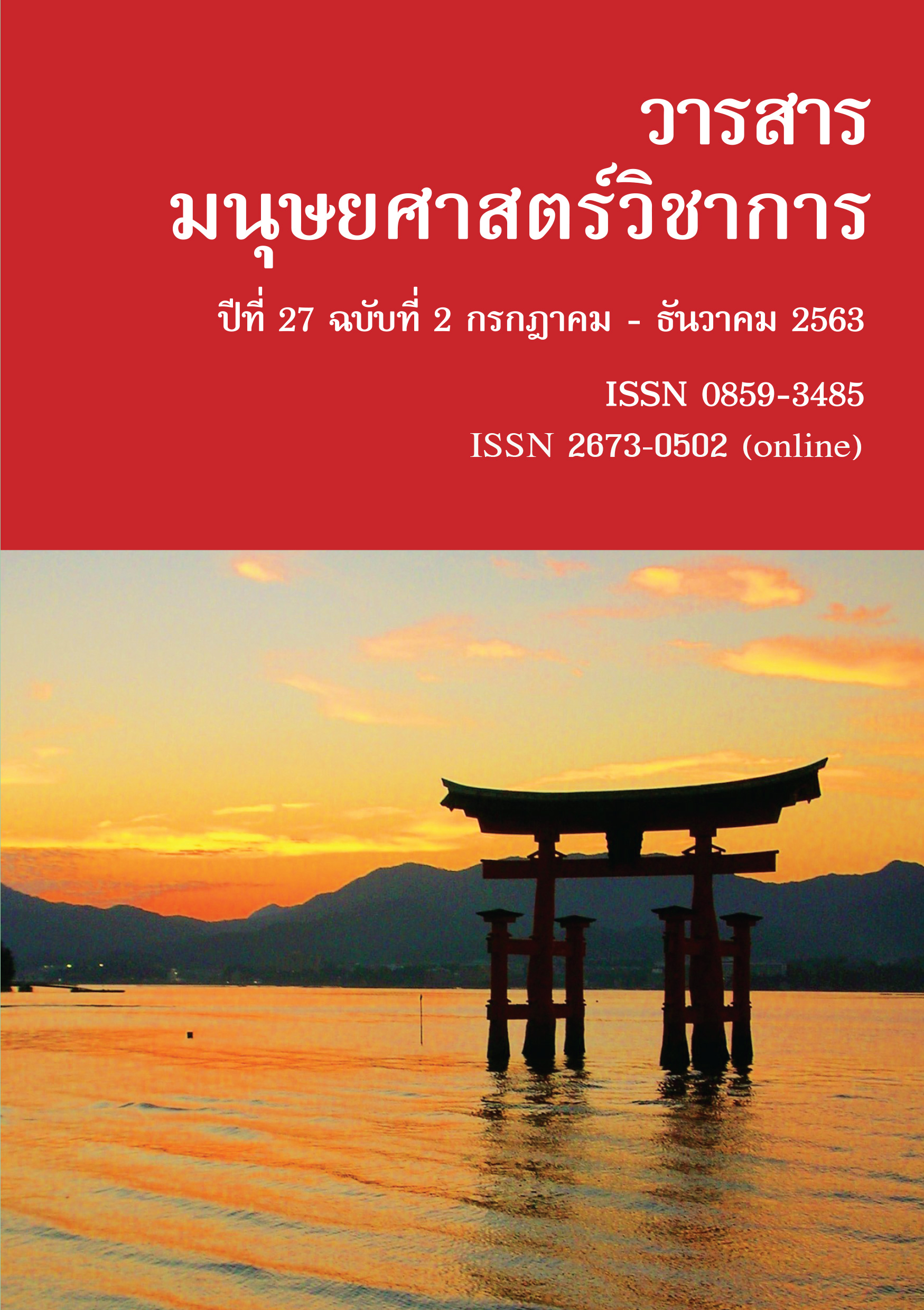Purposive Clauses in Thai from Typological Perspective
Main Article Content
Abstract
This academic article aims at investigating and comparing purposive clauses in Thai from a typological perspective in two main facets: conceptual structure and formal mechanism. Data from various languages were collected from previous research and studies while examples from Thai were collected and adjusted from the Thai National Corpus (TNC) under the Patronage of Her Royal Highness Princess Mahachakri Sirindhorn. It was found that the conceptual structure of purpose and the formal mechanisms of pu rposive
clauses in Thai were similar to those found in other languages. Conceptual structure of purpose in Thai is comprised of three concepts: volitionality, target-directedness and future orientation. It can be posited that purpose is a universal concept due to the fact that when compared to various languages, this concept possesses comparable attributes as mentioned earlier. In Thai, the concept of purpose is encoded through linguistic representations called purposive clauses or purposive constructions by means of (1) th e use of
grammatical markers, which can be divided into two categories: subordinator and preposition, and (2) the use of serial verb construction. Affixation is not found as an encoding strategy for the aforementioned concept.
Article Details
References
กิ่งกาญจน์ เทพกาญจนา. (2553). หน่วยสร้างกริยาเรียงต้นแบบในภาษาไทย. ใน อมรา ประสิทธิ์รัฐสินธุ์ (บรรณาธิการ), หน่วยสร้างที่มีข้อขัดแย้งในไวยากรณ์ ไทย หน่วยสร้างคุณานุประโยค หน่วยสร้างประโยคเติมเต็ม หน่วยสร้างกริยา เรียง หน่วยสร้างกรรมวาจก (หน้า 66-173). (พิมพ์ครั้งที่ 2). กรุงเทพฯ: โรง พิมพ์แห่งจุฬาลงกรณ์มหาวิทยาลัย.
กิ่งกาญจน์ เทพกาญจนา. (2559). Grammaticalization กระบวนการกลายเป็นรูป ไวยากรณ์. กรุงเทพฯ : โครงการเผยแพร่ผลงานวิชาการ ฝ่ายวิจัย คณะอักษร ศาสตร์ จุฬาลงกรณ์มหาวิทยาลัย.
ชาฎินี มณีนาวาชัยและกิ่งกาญจน์ เทพกาญจนา. (2559). การกลายเป็นคำไวยากรณ์ของคำกริยา ไป เป็นคำบ่งชี้ทัศนภาวะ. วารสารมนุษยศาสตร์, 23(1), 39-69.
พิรุฬห์ ปิยมหพงศ์. (2559). คุณสมบัติทางวากยสัมพันธ์และอรรถศาสตร์ของตัวบ่งชี้ ผู้รับประโยชน์ “เพื่อ” และ “ให้” ในภาษาไทย (วิทยานิพนธ์มหาบัณฑิต สาขา ภาษาศาสตร์). จุฬาลงกรณ์มหาวิทยาลัย, กรุงเทพฯ.
วิภาส โพธิแพทย์. (2561). ภาษาไทยในมุมมองแบบลักษณ์ภาษา. กรุงเทพฯ : โครงการเผยแพร่ผลงานวิชาการ ฝ่ายวิจัย คณะอักษรศาสตร์ จุฬาลงกรณ์ มหาวิทยาลัย.
อมรา ประสิทธิ์รัฐสินธุ์. (2553). หน่วยสร้างกรรมวาจก. ใน อมรา ประสิทธิ์รัฐสินธุ์ (บรรณาธิการ), หน่วยสร้างที่มีข้อขัดแย้งในไวยากรณ์ไทย หน่วยสร้าง คุณานุประโยค หน่วยสร้างประโยคเติมเต็ม หน่วยสร้างกริยาเรียง หน่วยสร้าง กรรมวาจก (หน้า 174-273). (พิมพ์ครั้งที่ 2). กรุงเทพฯ: โรงพิมพ์แห่ง จุฬาลงกรณ์มหาวิทยาลัย.
Croft, W. (2003). Typology and universals. (2nd Ed). Cambridge: Cambridge University Press.
Croft, W. and Cruse, D.A. (2004). Cognitive Linguistics. Cambridge: Cambridge University Press.
Daniel, M. (2010). Linguistic typology and the study of language. In J. J. Song (Ed.), The Oxford Handbook of Linguistic Typology. Oxford: Oxford University Press.
Diessel, H. (2001). The ordering distribution of main and adverbial clauses: A typological study. Language 77(2): 433-55.
Diller, A.V.N. (2006). Thai Serial Verbs: Cohesion and Culture. In A.Y. Aikhenvald and R.M.W. Dixon (Eds.), Serial Verb Constructions A Cross-linguistic Typology (pp. 160-177). Oxford: Oxford University Press.
Evans, V. and Green, M. (2006). Cognitive Linguistics: An Introduction. Edinburgh: Edinburgh University Press.
Hasplemath, M. (2003). The geometry of grammatical meaning: sem antic maps and cross-linguistic comparison. In M. Tomassello (Ed.), The new psychology of language: cognitive and functional approaches to language structure Vol.2. London: Lawrence Erlbaum Associates.
Haspelmath, M. (2008). Comparative concepts and descriptive categories in cross-linguistic studies. Ms., MPI Leipzig. Available online at .
Heine, B. (1990). The dative in Ik and Kanuri. In W. A. Croft, S. Kemmer, & K. Denning (Eds.), Studies in Typology and Diachrony: Papers presented to Joseph H. Greenberg on his 75th birthday (pp. 129-149). Amsterdam/ Philadelphia: John Benjamins.
Iwasaki, S., & Ingkaphirom, P. (2009). A Reference Grammar of Thai. Cambridge: Cambridge University Press.
Moravcsik, E. A. (2013). Introducing Language and Typology. Cambridge: Cambridge University Press.
Öztürk, B. (2006). Case-driven Agree, EPP and passive in Turkish. In W. Abraham and L. Leisiö (Eds.), Passivization and Typology Form and Function (pp. 383-402). Amsterdam/Philadelphia: John Benjamins.
Prasithrathsint, A. (2006). Development of the thùuk passive marker in Thai. In W. Abraham and L. Leisiö (Eds.), Passivization and Typology Form and Function (pp. 115-131). Amsterdam/Philadelphia: John Benjamins.
Rice, S., & Kabata, K. (2007). Crosslinguistic grammaticalization patterns of the allative. Linguistic Typology, 11(3), 451-514.
Schmidtke-Bode, K. (2009). A Typology of Purpose Clauses. Amsterdam/ Philadelphia: John Benjamins.
Tallerman, M. (2011). Understanding Syntax. (3rd ed.). London: Hodder Education.
Thepkanjana, K. (2008). Verb serialization as a means of expressing complex events in Thai. In B. Lewandowska-Tomaszczyk (Ed.), Asymmetric Events (pp. 103-120). Amsterdam/Philadelphia: John Benjamins.
Thepkanjana, K., & Uehara, S. (2015). Effects of Constituent Orders on Functional Extension Patterns of the Verbs for Give: A Contrastive Study of Thai and Mandarin Chinese. Language and Linguistics, 16(1), 43-68.


